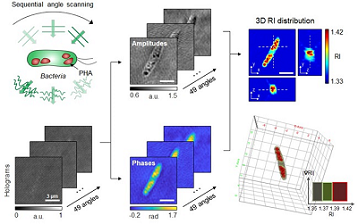DAEJEON, South Korea, Aug. 4, 2021 — Using 3D optical diffraction tomography (ODT), scientists at KAIST (formerly the Korea Advanced Institute of Science and Technology) gained insight into how the biodegradable polyester polyhydroxyalkanoate (PHA) accumulates in the cells of living bacteria. PHA is considered a sustainable and ecofriendly substitute to existing synthetic plastics.
Increased understanding of how PHA is formed, and of its characteristics, could further its use as an alternative to petroleum-based plastics.
The researchers performed 3D, quantitative, label-free analysis of PHA granules in individual, live bacterial cells by measuring the refractive index distributions using ODT. The approach allowed them to visualize the cells in 3D, perform a quantitative analysis of the cells, and study intracellular PHA granules at the single-cell level. The team quantified physical properties of the granules, such as weight, volume, density, and localization, by measuring the 3D refractive index distributions.

Schematic process of 3D optical diffraction tomography for the bacterial cell accumulating the bioplastic, polyhydroxyalkanoate (PHA). A cell sample is illuminated at multiple sequential illumination angles (left, top). From the raw holograms recorded at individual angles (left, bottom), quantitative amplitude and phase information (middle) is retrieved, and the 3D refractive index distribution (right, top) is reconstructed. The 3D rendering image of the sample is then obtained (right, bottom). Courtesy of KAIST.
Using ODT, the researchers performed statistical analyses of hundreds of single cells, focusing on cells that accumulated the type of PHA known as poly(3-hydroxybutyrate), or PHB. They examined the formation and growth of PHB granules in the cells of Cupriavidus necator and recombinant Escherichia coli harboring C. necator PHB biosynthesis pathways.
Through their statistical ODT analysis of the bacterial cells, the researchers successfully observed characteristics for density and localization of PHB granules in vivo. Comparative analyses of the native and recombinant PHB strains revealed distinctive differences in the density and localization of the granules in the two micro-organisms, providing insight into the spatiotemporal localization of PHA granules in vivo.
The team also presented 3D time-lapse movies showing the processes of PHA granule formation combined with cell growth and division.
The researchers said that previous investigations of live PHA granules have relied on fluorescence microscopy, transmission electron microscopy (TEM), and electron cryotomography. Because TEM analysis requires cells to be fixed and sectioned, it cannot be used to investigate living cells. Fluorescence-based techniques require fluorescence labeling or dye staining, and invasive exogenous dyes can affect the physiology and viability of the cells.
Using 3D holographic microscopy, the KAIST team was able to overcome the limitations of these techniques and perform an in-depth analysis of bacterial cells accumulating PHA.
“This study provides insights into the morphological and physical characteristics of in vivo PHA as well as the unique mechanisms of PHA granule formation that undergo the phase transition from soluble monomers into the insoluble polymer, followed by granule formation,” professor Sang Yup Lee said. “Through this study, a deeper understanding of PHA granule formation within the bacterial cells is now possible. ... This study will help develop various bioplastics production processes in the future.”
PHA has similar properties to general-purpose plastics such as polyethylene and polypropylene; it can be used in industrial applications, such as container packaging and disposable products. The researchers’ 3D imaging and quantitative analysis of the bioplastic PHA using ODT could help scientists find better ways to biosynthesize sustainable substitutes for human-made plastics.
The research was published in PNAS
(www.doi.org/10.1073/pnas.2103956118).